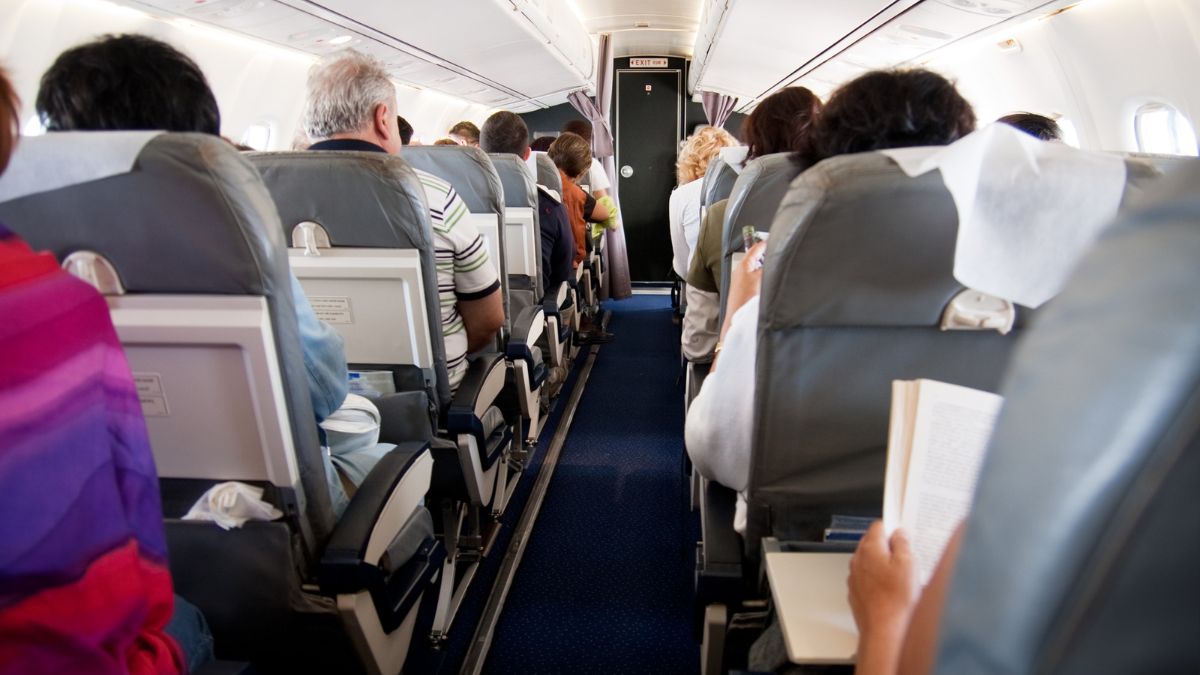How Long Can An Airline Keep You On A Plane At The Gate? When Is Compensation Due?

As participants in Amazon Associates and other programs, we earn from qualifying purchases. This comes at no additional cost to you. For more details, see our Affiliate Disclosure.
You’ve boarded your flight, stowed your carry-on, and settled into your seat. But time ticks on, and the plane remains grounded at the gate. While delays are often an unfortunate part of air travel, there’s a limit to how long you can be kept waiting in a stationary plane. Just how long can an airline keep you at the gate before it’s obliged to compensate? Let’s delve into the regulations and guidelines that protect air travelers.
HIGHLIGHTS
- Extended tarmac delays during peak travel times such as holidays or weekends are more likely due to crowded airports and increased air traffic.
- Regulations such as EU Regulation 261/2004 and U.S. DOT guidelines establish passenger rights and compensation criteria for flight delays and disruptions.
- Airlines must provide essential amenities during prolonged tarmac waits, including food and water after a two-hour delay.
- Documentation, including the retention of boarding passes and being familiar with an airline’s contract of carriage, is crucial for claiming compensation.
Understanding Flight Delays: The Basics
Air travel, for all its conveniences, is not immune to interruptions. Flight delays can stem from a myriad of reasons, ranging from unpredictable weather patterns to mechanical issues.
At its core, a delay refers to any instance when a flight takes off later than its scheduled departure time. While some delays are brief and cause little disruption, others can be long and lead to missed connections or extended waiting periods on the tarmac.
Knowing the root causes of these delays can help travelers set realistic expectations and navigate unforeseen hiccups more effectively.
Legal Limits: How Long Can They Keep You Waiting?
When it comes to keeping passengers on a plane that’s on the tarmac, regulations vary by country, but many have established rules to protect travelers’ rights. In the United States, for example, the Department of Transportation (DOT) has set strict guidelines on tarmac delays.
Domestic Flights: For U.S. domestic flights, airlines are prohibited from keeping passengers on a delayed plane on the tarmac for more than three hours. After this point, the airline must offer an opportunity for passengers to disembark.
International Flights: For international flights arriving or departing from the U.S., the limit is typically set at four hours. However, exceptions can be made for security, safety, or air traffic control-related reasons.
Mandatory Provisions: During any tarmac delay, airlines are obliged to provide adequate food and water after two hours, maintain operable lavatories, and offer medical assistance if needed.
Penalties: Airlines that violate these regulations can face hefty fines, often thousands of dollars per passenger.
It’s worth noting that these limits pertain to the U.S. and its carriers. Travelers should be aware that rules may differ when flying in other parts of the world or with foreign airlines. It’s always advisable to familiarize oneself with the regulations of the country one is flying to or from to be fully informed of one’s rights.
Factors Leading to Extended Tarmac Delays
Extended tarmac delays can be frustrating for passengers. However, understanding the reasons behind them can provide clarity. While each delay may have its unique circumstances, there are common factors that can lead to passengers being kept on the plane longer than expected.
- Weather Disruptions: Adverse weather conditions, such as thunderstorms, fog, or blizzards, can prevent safe take-offs or landings. These conditions might lead to a backlog of planes waiting for a clear window to fly.
- Air Traffic Congestion: Busy airports or airspaces can get congested, causing a hold-up. Air traffic control may delay takeoff or landing to manage the flow of aircraft efficiently and safely.
- Security Concerns: Unexpected security threats or issues can halt operations. In such cases, passengers may be kept on board while authorities address the situation.
- Mechanical Problems: If a technical issue is detected just before takeoff, the crew might decide it’s safer to address the problem while on the tarmac rather than returning to the gate, especially if the airport is crowded.
- Crew Availability: Flight and cabin crews have regulated work hours. If a delay causes them to exceed these limits, there may be a wait for a replacement crew.
- Gate Availability: Sometimes, planes are ready to depart or have already landed but are unable to access a gate due to congestion or other ongoing activities at the airport.
- Customs and Immigration Delays: For international flights, there may be instances where customs and immigration are not ready or available to process passengers.
- Operational Concerns: Other unforeseen operational issues, like loading of critical cargo, last-minute paperwork, or alignment with airport protocols, might contribute to the delay.
While tarmac delays can be taxing, they are often the result of efforts to ensure passenger safety and efficient airport operations. It’s beneficial for travelers to be informed, patient, and prepared for such eventualities.
Compensation Rules: What Are Your Rights?
When it comes to extended tarmac delays, passengers are not left entirely at the mercy of airlines. Several jurisdictions have established rights and compensation rules to ensure the well-being of travelers. In the United States, for instance, the Department of Transportation mandates that airlines cannot leave passengers on the tarmac for more than three hours on domestic flights or four hours on international flights without offering them an opportunity to disembark.
Beyond the delay timeframes, airlines are also legally obligated to provide essential amenities. After two hours of delay, airlines must supply adequate food and water. They must also ensure that lavatories are operable and, if necessary, medical assistance is available.
If airlines fail to comply with these standards, they can face significant fines. In some cases, these fines can amount to thousands of dollars per passenger. However, it’s crucial for passengers to understand that these rules primarily apply to U.S. carriers and flights within, to, or from the U.S. For international flights or when flying with non-U.S. carriers, the regulations can differ.
Compensation is not always guaranteed, and it can vary based on the airline’s policies and the specific circumstances of the delay. However, being well-informed about these rights is the first step for passengers to ensure they are treated fairly and appropriately in the event of extended delays.
Claiming Compensation: The Steps to Follow
Claiming compensation for extended tarmac delays or other flight disruptions can be a daunting process for passengers. However, following a structured approach can simplify the procedure and increase the likelihood of a successful claim.
Step 1: Document Everything: As soon as you realize you’re facing an extended delay, start documenting. Take note of the time the delay starts, any announcements made, and the duration of the delay. Pictures or videos, especially those with time stamps, can be invaluable evidence.
Step 2: Know Your Rights: Familiarize yourself with the regulations that pertain to your situation, whether it’s based on local laws, international treaties, or specific airline policies. The more you know about what you’re entitled to, the better equipped you’ll be to present your case.
Step 3: Keep Receipts: If you incur any expenses as a direct result of the delay, like meals or accommodation, ensure you keep the receipts. They will be essential when seeking reimbursement.
Step 4: Reach Out to the Airline: Before pursuing formal compensation, get in touch with the airline’s customer service. Explain the situation calmly, provide your evidence, and inquire about the next steps for compensation. Sometimes, this direct approach can yield positive results without further escalation.
Step 5: File a Formal Complaint: If your initial outreach does not yield satisfactory results, file a formal complaint with the airline. Detail the events, provide all the evidence you’ve gathered, and specify the compensation you believe you’re entitled to.
Step 6: Seek Third-party Assistance: If the airline is unresponsive or dismisses your claim, consider turning to third-party organizations or legal platforms that specialize in flight compensations. They can offer guidance, support, and in some cases, directly handle the claim on your behalf.
Step 7: Stay Persistent: While it’s essential to remain patient, it’s equally important to be persistent. Regularly follow up on your claim and keep track of all communications. If you’re convinced of your eligibility, don’t be easily deterred.
Remember, the process can sometimes be lengthy and require a fair bit of effort. However, staying informed, organized, and determined can significantly increase your chances of receiving the compensation you deserve.
Preventing Prolonged Wait Times: Tips for Travelers
While travelers can’t control all aspects of their flight experience, there are proactive steps one can take to minimize the risk of prolonged wait times on the tarmac or at the gate. Here are some handy tips for travelers looking to ensure a smoother journey:
- Book Direct Flights: Whenever possible, opt for direct flights. The fewer connections, the fewer chances for prolonged waits due to factors like missed connections or cascading delays from earlier flights.
- Avoid Peak Travel Times: Flights during peak travel times, such as holidays or weekends, tend to be busier. Crowded airports can increase the likelihood of gate availability issues and extended delays.
- Choose Early Flights: Morning flights typically have fewer delays than afternoon or evening flights. If a morning flight does get delayed, there’s a higher chance of it getting back on track later in the day.
- Check Airport Ratings: Before booking, review the on-time performance ratings of both the airline and the departure and arrival airports. Some airports are notorious for frequent delays due to factors like air traffic congestion.
- Monitor Weather Forecasts: While you can’t change the weather, being aware of potential storms or adverse conditions can help you prepare mentally and logistically for possible delays.
- Be App Savvy: Download the airline’s app and other flight tracking apps. These often provide real-time updates and can alert you to potential delays before you even reach the airport.
- Stay Updated on Airline News: Strikes, technical issues, or other large-scale disruptions can affect multiple flights. Staying informed about the latest news related to your airline can give you a heads-up on potential prolonged waits.
- Pack Essentials in Carry-On: In the event of a delay, having essentials like medications, snacks, a water bottle, and entertainment in your carry-on can make the wait more bearable.
Consider Travel Insurance: Some travel insurance policies offer compensation or coverage for prolonged tarmac delays, making them a valuable investment for frequent travelers.
While no strategy guarantees a delay-free experience, being proactive and prepared can reduce stress and make any waiting periods more manageable.
Know Your Rights: Navigating Airline Policies
When it comes to air travel, understanding your rights can be the key to ensuring a smoother journey and appropriate compensation in case of disruptions. Airline policies often differ based on the carrier and region, but there are common principles every traveler should know.
First and foremost, always read the contract of carriage for your chosen airline. This document outlines the terms and conditions of your relationship with the airline, detailing the rights and obligations of both parties. While it can be dense, it provides clarity on issues ranging from baggage policies to compensation for delays.
For those traveling to, from, or within the European Union, the EU Regulation 261/2004 is essential to understand. This regulation establishes rules for compensation and assistance to passengers in cases of denied boarding, flight cancellations, or prolonged delays. The specifics can vary, but knowing its existence is the first step towards claiming rights under it.
Similarly, in the United States, the Department of Transportation (DOT) provides regulations on tarmac delays, ensuring passengers are treated with fairness during extended waits. The DOT mandates essential amenities, opportunities to disembark after a set time, and potential penalties for airlines that do not adhere.
Remember, airlines often have customer service plans in place which outline their commitments to passengers. While these plans might not offer legal recourse, they can guide your expectations and interactions with airline representatives.
Lastly, always retain your boarding pass and booking information. These documents can be vital when seeking compensation or lodging a complaint. In the complex world of air travel, being informed and proactive is your best defense against unforeseen hitches.






